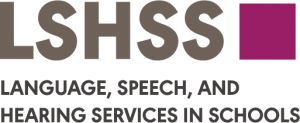
Editor-in-Chief: Karla N. Washington, Ph.D., CCC-SLP, S-LP(C), BCS-CL, University of Toronto
Journal Citation Reports ™ Impact Factor
2.9 (2024)
3.2 (5-year)
Mission
LSHSS publishes peer-reviewed research and other scholarly articles pertaining to the practice of audiology and speech-language pathology in the schools, focusing on children and adolescents. The journal is an international outlet for clinical research and is designed to promote development and analysis of approaches concerning the delivery of services to the school-aged population. LSHSS seeks to advance evidence-based practice by disseminating the results of new studies as well as providing a forum for critical reviews and meta-analyses of previously published work.
Scope
The broad field of audiology and speech-language pathology as practiced in schools, including aural rehabilitation; augmentative and alternative communication; childhood apraxia of speech; classroom acoustics; cognitive impairment; craniofacial disorders; fluency disorders; hearing-assistive technology; language disorders; literacy disorders including reading, writing, and spelling; motor speech disorders; speech sound disorders; swallowing, dysphagia, and feeding disorders; voice disorders.
Publication Frequency
LSHSS is continuously published, with articles added to the Newly Published section of the website as they complete production. The journal also publishes issues on a quarterly basis in January, April, July, and October, as well as special issues on an ad hoc basis at other times throughout the year.
Manuscript Types
Research Article
A research article is a full-length article presenting important new research results. Research articles include an abstract, introduction, methods and results sections, discussion, and relevant citations.
Suggested Maximum Length:
40 manuscript pages including citations, tables, and figures (supplemental materials not included in length guidelines).
Research Note
A research note is a brief manuscript presenting pilot, preliminary, and/or exploratory findings or a new method for the collection or analysis of data. Includes a short abstract and introductory paragraph. The scientific findings should be explained and documented concisely.
Suggested Maximum Length:
20 manuscript pages including citations, tables, and figures (supplemental materials not included in length guidelines).
Review Article
“Review Article” is an umbrella term covering systematic reviews (with or without meta-analyses), historical reviews of a body of research, description of an author’s programmatic research, and possibly other types of reviews. Reviews can be a comprehensive overview, or they can be focused on a narrow body of research. Reviews should be accessible to knowledgeable readers not expert in the subject area. They should be prepared with the same rigor as a research article reporting specific results.
Suggested Maximum Length:
40 manuscript pages including citations, tables, and figures (supplemental materials not included in length guidelines).
Clinical Focus
A clinical focus is an article that may be of primary clinical interest but may not have a traditional research format. Case studies, descriptions of clinical programs, and innovative clinical services and activities are among the possibilities
Suggested Maximum Length:
40 manuscript pages including citations, tables, and figures (supplemental materials not included in length guidelines).
Tutorial
A tutorial is an educational exposition covering recent literature on topics of interest to clinicians and other scholars
Suggested Maximum Length:
40 manuscript pages including citations, tables, and figures (supplemental materials not included in length guidelines).
Technical Report
A technical report is a brief article describing a pretrial feasibility or pilot efficacy study that addresses important clinical questions (i.e., whom to treat with a given technology, when to treat, and for how long).
Suggested Maximum Length:
30 manuscript pages including citations, tables, and figures (supplemental materials not included in length guidelines).
Viewpoint
A viewpoint includes scholarly based opinion(s) on an issue of clinical relevance that currently may be neglected, controversial, or related to future legislation, or could serve to update the readership on current thinking in an area.
Suggested Maximum Length:
10 manuscript pages including citations, tables, and figures (supplemental materials not included in length guidelines).
Commentary
A commentary is a short, timely article that spotlights current issues of direct interest to the communication sciences and disorders community. Commentary articles are often extensions or reactions to positions put forward in viewpoint articles.
Suggested Maximum Length:
10 manuscript pages including citations, tables, and figures (supplemental materials not included in length guidelines).
Letter to the Editor
A letter to the editor communicates opinions about material previously published in the journal or views on topics of current relevance.
Note:
A letter relating to work published in the journal will be referred to the author(s) of the original item for a response, which may be published along with the letter.
Introduction
An introduction is generally a short article presented at the beginning of a forum, special issue, or special topic collection (please note that special issues require prior approval). It may be written by, as applicable, the journal’s editor-in-chief, an editor, or the guest editor involved and is intended to provide background information on the topic covered, brief explanations of the articles, and the aims or goals of the forum or special issue.
Suggested Maximum Length:
10 manuscript pages, including citations, tables, and figures.
Epilogue
An epilogue is a short article at the end of a forum, special issue, or special topic collection that is written by, as applicable, the journal’s editor-in-chief, an editor, or the guest editor involved (please note that special issues require prior approval). An epilogue should include a summation of the preceding articles’ findings and may draw broader conclusions than the individual articles. An epilogue is typically limited to 10 manuscript pages, including citations, tables, and figures.
Suggested Maximum Length:
10 manuscript pages, including citations, tables, and figures.
Erratum
An erratum is a correction of any sort to an already published article.
Note:
An erratum should include the full citation reference for the original article (including the digital object identifier [DOI]), a summary of the error, and what the text should have said.




